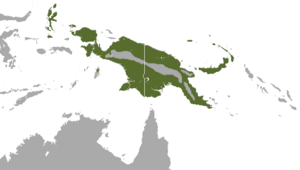Common tube-nosed fruit bat facts for kids
Quick facts for kids Common tube-nosed fruit bat |
|
|---|---|
 |
|
| Conservation status | |
| Scientific classification | |
| Genus: |
Nyctimene
|
| Species: |
albiventer
|
 |
|
| common tube-nosed fruit bat range | |
The common tube-nosed fruit bat (Nyctimene albiventer) is a type of megabat found in the family Pteropodidae. These bats live on islands north of Australia, and also in countries like Indonesia, Papua New Guinea, the Philippines, and the Solomon Islands.
Contents
What is a Common Tube-Nosed Fruit Bat?
The common tube-nosed fruit bat gets its name from its unique tube-shaped nostrils. These bats are part of a larger group called megabats, which are usually bigger than other bats. They are also known as fruit bats because of what they like to eat!
How Was This Bat Named?
The first time this bat was officially described was in 1863. A scientist named John Edward Gray gave it the scientific name Nyctimene albiventer. This name helps scientists around the world know exactly which animal they are talking about.
What Do Common Tube-Nosed Fruit Bats Do?
These bats usually like to be alone. During the day, they find a quiet spot to rest. They often hang upside down in dry leaves, hidden in the lower or middle parts of the forest.
How Do They Have Babies?
Like most megabats, common tube-nosed fruit bats usually have one baby at a time, once a year. The mother bat carries her baby with her until it is old enough to be left safely while she goes out to find food.
What Do They Eat?
Common tube-nosed fruit bats mainly eat fruit. They are called frugivores, which means "fruit-eaters." When they eat, they hang sideways and bite off small pieces of fruit. Sometimes, they also drink nectar from flowers or eat tiny bits of insects.
Where Do These Bats Live?
You can find Nyctimene albiventer on islands north of Cape York peninsula in Australia. They do not live on the Australian mainland itself. Their home stretches from the main island of Papua New Guinea to parts of Indonesia and other smaller islands in the region. These bats can live in many different places, from sea level up to about 1,900 meters (about 6,200 feet) high.
Are They in Danger?
The International Union for Conservation of Nature (IUCN) says that the common tube-nosed fruit bat is a species of "least concern." This means that, for now, there are plenty of them, and they are not considered to be in immediate danger of disappearing.
However, scientists think that there might be different types of these bats that look very similar but are actually separate species. If that's true, some of those specific island groups, like those near the Kei and Moluccan Islands, might be facing threats. These threats could be things like losing their homes or other problems. Scientists are still studying this to understand if any specific groups of these bats need more protection.


